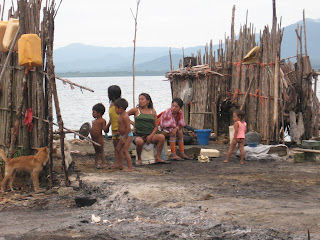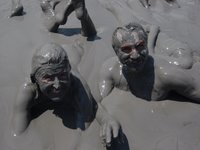Cartagena to Panama via the San Blas Islands






 The first stop was at the
The first stop was at the The waters around the 
After the 
Once we exited the shoals we had two choices, sail westward, to Subzuro on the Colombia/Panama border, and deal with the mounting seas, or, 12 miles east and anchor behind a river
The locals could not have been more welcoming, I guess they are happy to have folks dropping in for a visit. Subzuro is not accessible by road but is a significant border town and has a large military presence. We were required to visit the commadante and report in. He just inspected our passports, made an entry in his log book and asked how long we wanted to stay. We asked what was acceptable and he said up to two weeks was ok. Not bad considering our Colombian visa had expired and we had cleared out also. He was very nice and suggested we take ‘Via de Miel” the honey path to the mountain top where they hav
Our next stop was in Escoses, the eastern San Blas islands (the land of the little Kuna Indians), at the site of an old Scottish settlement. I don’t remember the exact details but, a group of Scotts found this place ideal for a settlement, built a small fort, and began to farm. They fought off several foreign raiding parties over the years but disease and isolation forced them to return to their homeland. Many years later another group had the bright idea of returning and trying again. However, the Spaniards had occupied the place since and didn’t want to give it up. There is a very small Kuna village there on the ruins but we weren’t allowed to visit as it was a ceremonial period. On the shore there was a small Kuna town of temporary plantation workers who we got to know. The nearby plantation hired them
small Kuna village there on the ruins but we weren’t allowed to visit as it was a ceremonial period. On the shore there was a small Kuna town of temporary plantation workers who we got to know. The nearby plantation hired them

We traded a few beers for fish, bananas, plantains, fish and lobster with them. They visited and chatted while smoking our cigarettes, Meri’s menthols were a hit. Once, Meri said she was out of smokes, they were getting a little demanding, and one of the guys pulled out a pack of menthols and offered her one. I cracked up laughing and said “I thought you didn’t have any smokes”, his reply was classic, “you never asked, just offered”! Any activity in the San Blas usually requires the Saila’s (Chief) permission and, often a fee ranging from $5-8. These guys weren’t bothered about money and asked if I wanted to go spearfishing with them, in our dinghy of course. We had a great time and caught quite a lot.
Tupak (Isla De Los Pinos)
Ustupu
Snug Harbour
Coco Banderos (West)
Cayos Chichime
Solidad Miria
Chichime (again)
Portobello
Colon for canal formalities.
With few exceptions each anchorage followed a similar pattern. We would drop anchor, be visited by a local representative of the chief, pay a small fee, get visited by Kunas offering Molas (traditional embroidered designs varying hugely in quality and price), fish, lobster, crabs, and sometimes fruit, we would relax and enjoy the beauty, go snorkeling, visit the towns and other boats.
In Ustupu our arrival coincided with the supply ship and we stocked up on fresh veggies and beer. With another couple we took a river tour with a local guide and swam in fresh water for a change. He pointed out a local cemetery which looked like a small village, complete with huts, furniture and gardens. I asked if family members spent nights there and he said “no, we build huts over the site to make the spirits feel at home and not forgotten”
Later in the village we met a very interesting guy who had traveled and studied in Europe and the USA. He explained many of the Kuna traditions, superstitions, and cultural taboos. We enquired about the numerous Albinos in the villages and he pointed out that inbreeding had become common with such small and isolated communities. Nowadays it’s possible to travel to distant villages and meet partners. Also, Kunas are now permitted to marry outside their caste.

Regrettably we didn’t have our camera handy as I was dying to photograph his T-shirt. It was a gift from the Seminol Indians in Florida and pictured 3 Indians (circa 1800’s) holding long rifles. The caption read “HOMELAND SECURITY – FIGHTING TERRORISM SINCE 14??” . I don’t remember the exact date but assume it referred to Christopher Columbus’s discovery of the ‘New World’. I have to get one!

Coco Banderos (west) was memorable for 2 reasons. Firstly, we had the whole little anchorage to ourselves for 3 days, then had to share with some very nice Kuna fishermen who stayed in a lean-to on the beach. They sold us a huge grouper fish for $4 and were happy to stop by and chat. The eastern anchorage had 11 boats in it and looked like a parking lot. Now you know why our last boat was called ‘Splitter’. Secondly, the snorkeling was some of the best we had seen in the area and it was in abundance right behind the boat. Sometimes you just don’t want other boats around!

With Christmas and New Year a week away we opted for the anchorage in Chichime rather than the extremely popular ‘Swimming pool’ in the Hollandes Cays. The boaters there had built driftwood furniture on a small island and had regular pot luck parties, rubbish burning events, etc. No offence to them, but definitely not our cup or tea. Especially with the numbers expected there for the festive season.




 One evening we noticed a huge glow to the SE and hoped to god it wasn’t a village fire. Sure enough, next day on the radio net we heard that half the village of Solidad Miria had burned down and left dozens of families homeless and hungry. The net called for donations to be taken to Porvenir so a boat could deliver them as soon as possible. Wanting to do more we all weighed anchors and sailed to the island. Upon arrival we handed over whatever we could spare, food, clothes, shoes, pots and pans, cutlery, etc. The fire was so intense it melted even their cookware!
One evening we noticed a huge glow to the SE and hoped to god it wasn’t a village fire. Sure enough, next day on the radio net we heard that half the village of Solidad Miria had burned down and left dozens of families homeless and hungry. The net called for donations to be taken to Porvenir so a boat could deliver them as soon as possible. Wanting to do more we all weighed anchors and sailed to the island. Upon arrival we handed over whatever we could spare, food, clothes, shoes, pots and pans, cutlery, etc. The fire was so intense it melted even their cookware!
That day was also spent helping to cleanup the hut sites so that relief workers could erect emergency tents. Quite a shitty job, but it had to be done and many of the residents weren’t up to the task. They were simply shell shocked and trying to cope with the enormity of their lot.
After doing all we could it was back to Chichime and preparations for Portobello and onwards. We had a great sail in sheltered waters that soothed our consciences and reminded us to be grateful for the lives we’ve been handed this time round.
Next stop was Portobello for a breather and chance to do some minor provisioning. It’s also a historical town that shipped much of Spain’s ill gotten booty back to Europe. The sail was one of the sloppiest we’ve ever had and couldn’t wait for it to end. We even risked entering the harbour at night to get out of the multidirectional swells.
.JPG)
Portobello was a nice historical town with basic supplies, in a couple of supermarkets, scenic walks and views, friendly people and a very relaxed atmosphere. We were happy to relax for a few and enjoy the sights with our friends from Ospray, Marie, and Pagos. If we could have provisioned there, instead of Colon, there wouldn’t have been any hesitation. Still, we enjoyed our time and had a couple of picknics in the old Spanish ruins on either side of the bay.


.JPG)
.JPG)


0 Comments:
Post a Comment
<< Home